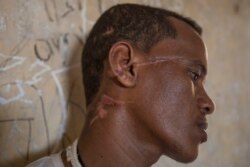People who fled fighting in Ethiopia’s Tigray area continue to tell stories of suffering as they gather in refugee camps.
At a simple medical center in Sudan, a doctor who is also a refugee cares for the hurt and sick. Tewodros Tefera sees many injuries: children hurt in explosions, wounds from axes and knives, and broken bones from beatings.
Recently, he treated the broken legs of refugee Guesh Tesla, a woodworker who just arrived at the camp.
He came with information about 250 young men taken from one village into neighboring Eritrea by Eritrean forces. Ethiopia denies Eritrean forces are involved in the fighting.
In late November, Guesh said he saw many bodies on the streets in his hometown of Rawyan. There, he said, Ethiopian soldiers beat him and took him to the border town of Humera. The Humera courthouse, he said, had been turned into a center for killing by militias from the neighboring Amhara area. He heard the screams of men being killed, and quietly escaped during the night.
“I would never go back,” he said.
It is impossible to know if these stories are true as Tigray remains almost completely cut off from the world. It has been more than 50 days since fighting began between Ethiopian forces and groups in Tigray. The Tigray people led the country’s government for nearly 30 years, but are now marginalized.
Ethiopian Prime Minister Abiy Ahmed continues to refuse international requests to bring humanitarian assistance to the area. He also refuses requests from those pressing for investigations of Ethiopian forces.
Last year, Abiy won the Nobel Peace Prize for political reforms. But this conflict threatens to end his peace-making activities.
“I know the conflict has caused unimaginable suffering,” Abiy wrote last week. He argued, however, that “the heavy cost we incurred as a nation was necessary” to hold the country together.
No one knows how many thousands of people have been killed in Tigray since the fighting began on November 4. The United Nations has said there are reports of artillery strikes on populated areas, civilians being targeted and looting.
Now, refugees are arriving from areas deeper inside Tigray. They have more severe trauma, Tewodros said. He said there are signs of starvation and dehydration and some gunshot wounds among the refugees.
In the future, the stories of refugees, like Tewodros and Guesh, and the people who are still in Tigray, will show how much abuse was carried out against people for ethnic reasons.
“Everyone looks at you and points out the part of you that doesn’t belong to them,” said Tewodros. He is both an ethnic Tigrayan and Amhara. “So, if I go to Tigray, they would pick up that I’m Amhara because Amhara is not a part of them. When I go to Amhara, they would pick up the part of Tigray because Tigray is not a part of them.”
Such differences have become deadly. Many ethnic Tigrayan refugees have accused ethnic Amhara fighters of targeting them. The Amhara militias are fighting with Ethiopian government forces.
Abrahaley Minasbo is a 22-year-old dancer. He said Amhara militia members pulled him from his home in Mai-Kadra on November 9. They beat him in the street with an axe and other tools, and they left him to die. He survived and made it to Sudan. His face is covered with scars.
For Tewodros, the conflict has been about the wounded civilians.
In November, he worked at a hospital in Humera that came under fire. He insisted some of the shelling came from the direction of Eritrea.
Fifteen bodies arrived at the hospital that first day, and eight the next, he said. The shelling continued. He and his colleagues fled, after moving wounded patients to a nearby village.
Tewodros and colleagues hid for two days in the forest, hearing gunfire. They later walked for more than 12 hours, crossing a river into Sudan, where he started treating wounded refugees for the Sudanese Red Crescent Society.
“Where we are now is extremely unsafe,” he said of the refugee center near the border. He said the Amhara fighters threaten the refugees from the other side of the river.
The militias “are more dangerous than the Ethiopian national forces,” he said.
I’m Susan Shand.
Nariman El-Mofty and Haleluya Hadero reported this story for the Associated Press. Susan Shand adapted it for Learning English. Mario Ritter, Jr. was the editor.
________________________________________________
Words In This Story
ax – n. a heavy tool used to chop wood
marginalize – v. to put or keep someone in a powerless or unimportant position within a society or group
incur – v. to cause yourself to have or experience something unpleasant or unwanted
loot – v. to steal from a place such as a store during a crisis of some kind
trauma – n. a very difficult experience, or a serious injury to the body or mind
dehydration – n. to lose too much water









